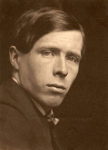
William Orpen
Irish, 1878-1931 (active England)
The Black Cap, 1928
oil on canvas
34 3/4 x 40 1/2 in.
SBMA, Gift of Robert Straus Estate
2006.44

Photo of Orpen by George Charles Beresford, 1903
It is a rare treat to see an Orpen original. Very few are exhibited in American museums. In his book, The Technique of Portrait Painting, 1935 c. (Philadelphia, J.B. Lippincott Company, publishers) artist and author Harrington Mann pays tribute to Orpen:
"The untimely death of Sir William Orpen has been a blow to modern British art. We have lost a painter who, while he had already achieved fame, would have carried the laurels of the British school of to-day to a still higher level had he lived. His work shows an amazing force of precision in the realization of individual character. He never failed to tell you all about his sitter—all that could be told in paint by the cleverest hand and the keenest eye. The face of the man before him was like the page of an open book, which he read with astonishing insight. He made a literal transcript, which he handed on to anyone who cared to know.
"It is the physical character which is of interest to the painter, but he knows that if he can but get this skin-deep truth he has got everything. Technically Orpen was splendidly equipped. There was no slashing sleight-of-hand like Boldini. There was neither the carefree dexterity of Hals, nor the facile skill of Sargent, but he had his own unerring precision of touch which gave him the proficiency necessary to produce his masterpieces.
"Even with his Irish sense of humour, Orpen always told the truth. This is real portraiture."
Every working portrait artist would do well to study Orpen.
COMMENTS
British painter, chiefly famous as one of the leading fashionable portraitists of his day. Orpen was a child prodigy and had a brilliant student career at the Slade School. He worked mainly in London but he kept up links with his native Ireland, teaching part-time at the Metropolitan School in Dublin, 1902–14. His style had much in common with that of his friend Augustus John, being vigorous and painterly but sometimes rather flashy.
He was at his best when he was away from his standard boardroom and drawing-room fare, and his numerous self-portraits are often particularly engaging, as he pokes fun at himself in character roles.
Up to the First World War he had a steady rise in worldly success and after the war he earned an average of about £35,000 a year, rising to over £50,000 a year in 1929—a colossal sum then. In 1920 a story appeared in London newspapers that he had refused an offer of £1,000,000 to work for a dealer in the USA, and he was one of the few British artists of his time capable of attracting public attention in such a way. Apart from portraits, Orpen also painted genre subjects, landscapes, interiors, nudes, and allegories, and he did memorable work as an Official War Artist in France. He also attended the 1919 Peace Conference in Paris and painted a large group portrait showing the Signing of the Peace in the Hall of Mirrors, Versailles, 28 June, 1919 (Imperial War Mus., London). His reputation faded badly after his death but revived greatly in the 1970s.
- The Oxford Dictionary of Art and Artists (Oxford University Press)
SBMA CURATORIAL LABELS
Orpen had a lifelong fascination with the theater, delighting in expressing in paint the ambiguity between reality and make-believe. At the Slade in 1899, he painted his early masterpiece The Play Scene from Hamlet (Private Collection) and, the following year, inspired by Ibsen, The Doll’s House (Tate Gallery, London).
- Ridley-Tree Reopening, 2021
